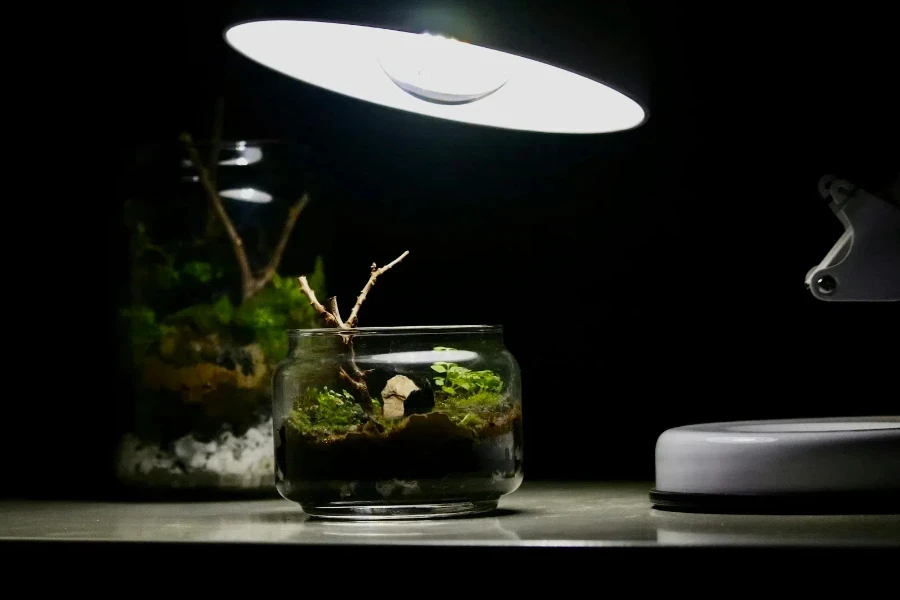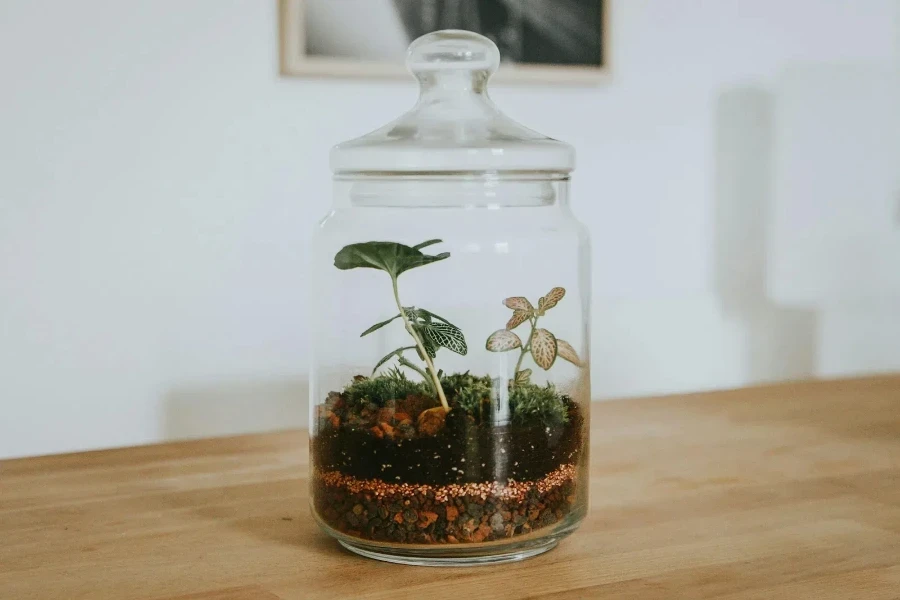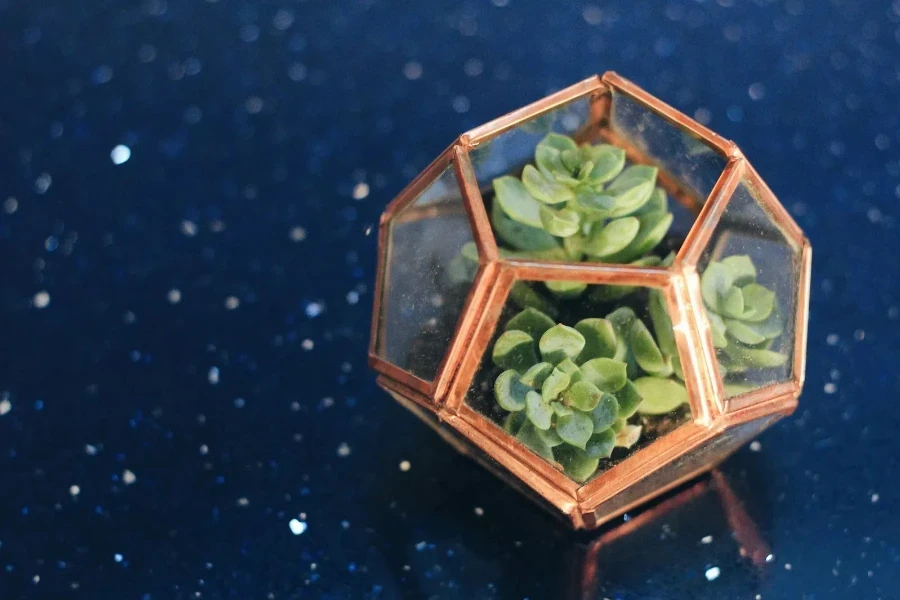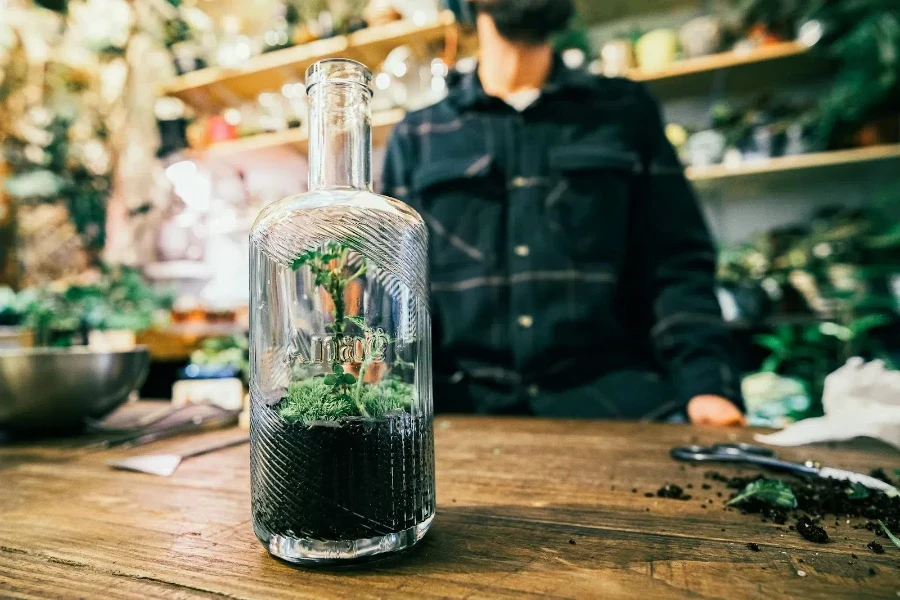Plant terrariums are becoming increasingly popular as a trendy decorative element in modern homes and a convenient option for plant lovers. These mini-ecosystems enclosed in a glass container are a unique way to bring a touch of nature into interior spaces with minimal effort.
Terrariums represent an interesting market opportunity for online and offline stores as they respond to the growing demand for sustainable and easy-to-care interior design products.
In this article, we’ll delve into the evolution of terrarium fashion and provide actionable advice on selecting the best items for successful resale. It also includes a tutorial on creating terrariums, helping retailers capitalize on this growing trend.
Table of Contents
The rising popularity of terrariums
The fundamental elements of a terrarium
Final thoughts
The rising popularity of terrariums
In recent years, closed terrariums have become a must-have for plant lovers and interior design enthusiasts. This trend has been fueled by growing environmental awareness and the desire to reconnect with nature, even in urban spaces. Moreover, urban homes and apartments are getting smaller, and people are increasingly seeking hobbies that are less time intensive.
As such, closed terrariums, in particular, have found an increasingly wider audience thanks to their ability to create a self-sustaining environment where plants can thrive and bring nature into spaces without needing constant care.
How the terrarium trend has evolved

Over the past decade, terrariums have made a triumphant return, emerging as the stars of interior design. This revival owes much to the burgeoning ‘plant parent’ movement and the rise of minimalist, Boho, and Japandi styles. Their quest for sustainable, natural, and low-maintenance décor solutions has propelled the terrarium into the limelight, with many houseowners preferring them over artificial plants.
According to market data, demand for houseplants and terrariums has increased steadily, with particularly significant growth in online sales. The global indoor plants market was valued at USD 10.45 billion in 2023 and is projected to grow at a CAGR of 3.88% to USD 14.72 billion by 2032.
This trend has been further accelerated by the COVID-19 pandemic, which has led many consumers to seek out new hobbies and invest more time and money in taking care of their homes. Terrariums have proven perfect for those who wanted to enrich their spaces with a touch of greenery but without the commitment required by traditional plants.
The fundamental elements of a terrarium
The beauty of terrariums lies in their simplicity and the variety of customization options available. For retailers, it is essential to understand the various components that make up a terrarium so as to best be able to offer a range of products that meet customer needs.
The perfect container

The container is the most visible and distinctive element of a terrarium, and it is therefore fundamental to a sale’s success. There are two main types: closed and open terrariums. The first consists of a glass container equipped with a lid. For these, once the soil and plants are watered, a real microclimate and autonomous ecosystem should form inside without human intervention, except for sporadic cleaning.
Meanwhile, the mechanism behind open terrariums differs in that water or fertilization are necessary throughout because they lack an autonomous ecosystem.
In both cases, however, various types of containers can be used to create a terrarium, each with their own characteristics and aesthetic appeal:
- Glass vases with lid: These are the most common containers for terrariums. Available in different shapes and sizes, from simple cylinders to sophisticated cloches, glass vases offer total visibility of the mini-ecosystem inside, enhancing the beauty of the plants and any accessories.
- Geometric terrariums: These containers are often made with glass and metal. They are especially popular with customers who love interior design, as they add a sculptural element to the decor and can be hung or placed on flat surfaces.
- Recycled containers: Thanks to an increased focus on sustainability, terrariums made from vintage or recycled containers are gaining popularity. Old jam jars, glass bottles, or light bulbs can be transformed into unique and charming terrariums.
Substrates

The substrate is the foundation of the terrarium and plays a crucial role in maintaining humidity and providing nutrients to the plants. Of course, which substrate is most suitable will vary depending on the plants growing inside, but in general it should contain:
- Gravel and pebbles: These materials often make up the bottom layer and ensure good drainage. Gravel can also create a decorative effect, adding an aesthetic touch to the terrarium.
- Soil: The most common substrate, and suitable for most terrarium plants.
- Activated charcoal: This is essential in closed terrariums, as it helps filter the air and keep the environment fresh and odor-free. It is a key element in ensuring the longevity of the terrarium.
Life inside the terrarium

The choice of plants is fundamental to the success of a terrarium. The plants must be compatible with the environmental conditions created by the container, such as humidity and light.
- Succulents and cacti: These plants are ideal for open or closed terrariums with low humidity levels. They require little water and are very durable.
- Ferns and moss: Perfect for closed terrariums, these plants thrive in moist, shaded environments. They offer a lush, green look, creating a mini forest landscape within the terrarium.
- Tropical plants: Plants such as fittonia or pilea require a humid and warm environment and are perfect for adding a touch of color and vitality.
Decorative accessories

In addition to plants and substrates, decorative accessories can transform a simple terrarium into a work of art. Consider stocking these main types:
- Miniature figurines: Small figurines of animals, houses, or characters can create a fairy-tale scene inside the terrarium. These details personalize a terrarium and make them unique.
- Stones and shells: These natural elements can also decorate a terrarium, adding texture and contrast
- Lighting: Lighting can play a decorative as well as functional role. Place colored or white LED lights inside or around the terrarium to create an eye-catching look.
Final thoughts
Plant terrariums offer a growing market opportunity for retailers and DIY stores looking to expand their home and garden product offerings. Understanding current trends and consumer preferences is essential to choosing the right vases, materials, or terrariums to resell.
With the right selection of containers, plants, and accessories, terrariums can become a high-impact decorative element and a flagship product for any store. Find everything you might need among the thousands of options on Chovm.com.





 বাংলা
বাংলা Nederlands
Nederlands English
English Français
Français Deutsch
Deutsch हिन्दी
हिन्दी Bahasa Indonesia
Bahasa Indonesia Italiano
Italiano 日本語
日本語 한국어
한국어 Bahasa Melayu
Bahasa Melayu മലയാളം
മലയാളം پښتو
پښتو فارسی
فارسی Polski
Polski Português
Português Русский
Русский Español
Español Kiswahili
Kiswahili ไทย
ไทย Türkçe
Türkçe اردو
اردو Tiếng Việt
Tiếng Việt isiXhosa
isiXhosa Zulu
Zulu